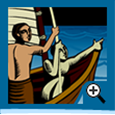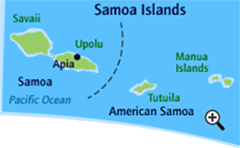The Canoe Is the People
Indigenous Navigation in the Pacific
Star Path
A star that is just rising or setting is a very good guide. A wayfinder steers towards the star that rises or sets in the direction of the destination island. A rising star, however, doesn’t go straight up from the horizon GLOSSARY horizon - the line where the earth and sky seem to meet (unless you are at the equator). It moves to the side of the island and soon is no longer a good guide. A wayfinder then uses the next star that rises in the same direction, and so on. There might be up to 10 stars in a star path for one night’s sailing, but only one might have a name.
Often, songs or stories are used to remember the star paths GLOSSARY star paths - the sequence of stars to follow from one island to another . A journey between two islands can have more than one star path. Any star path can only be used in a particular season. Six months later, the same stars are only above the horizon in the day and so can’t be seen. Different star paths are also used when there are strong currents GLOSSARY currents - the directional flow of the sea or winds
“When we sailed from Puluwat to Saipan [one of the Northern Mariana Islands] with Hipour’s sailing directions there were three courses: the direction in which the [island] lay, the direction to allow for the west-going current, and the third to allow for strong winds”
From David Lewis in Bader, H. and McCurdy, P., eds (1999).
“Each of the starpath leader stars has a star on either side of it. These side stars are used when there is strong current or wind conditions that would take the Vaka to the side if we do not adjust our heading.” Taumako Master Wayfinder Koloso Kaveia
“Te Paikae and Te Ula are dark places in the sky. We use these like we use stars.”
Taumako Master Wayfinder Koloso Kaveia
Gaiuli and Gaisina (Samoa, Polynesia)
A story tells of the journey of Gaiuli and Gaisina from Tutuila in what is now American Samoa to Manua Islands. First, they headed towards the star Matatula, then Tapuitea (the evening star) rose, and then Faipa and Tulalupe in the east. Then they went to Toloa (the Southern Cross), Sumu, and Luatagata rose – all close together. Then Taelo rose, and they headed towards it. Then, they passed Tiotala, and they headed towards that. When morning approached, Amoga (Orion’s Belt) and Lii (Pleiades) rose. They went towards Amoga. When it grew light, they faced Manua exactly.










